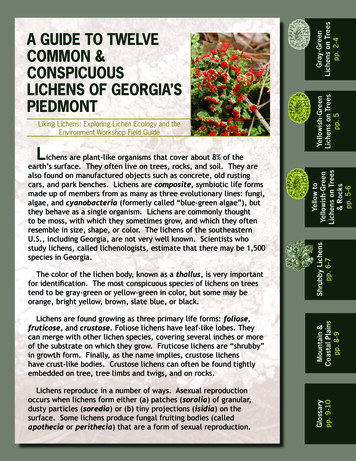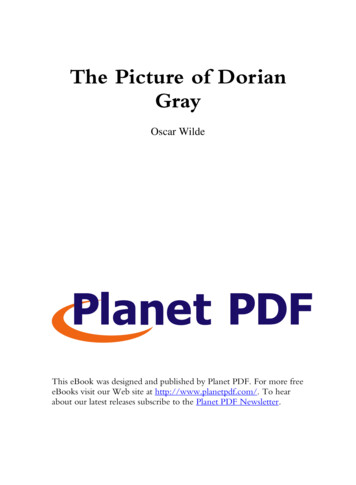
Transcription
The color of the lichen body, known as a thallus, is very importantfor identification. The most conspicuous species of lichens on treestend to be gray-green or yellow-green in color, but some may beorange, bright yellow, brown, slate blue, or black.Lichens are found growing as three primary life forms: foliose,fruticose, and crustose. Foliose lichens have leaf-like lobes. Theycan merge with other lichen species, covering several inches or moreof the substrate on which they grow. Fruticose lichens are “shrubby”in growth form. Finally, as the name implies, crustose lichenshave crust-like bodies. Crustose lichens can often be found tightlyembedded on tree, tree limbs and twigs, and on rocks.Lichens reproduce in a number of ways. Asexual reproductionoccurs when lichens form either (a) patches (soralia) of granular,dusty particles (soredia) or (b) tiny projections (isidia) on thesurface. Some lichens produce fungal fruiting bodies (calledapothecia or perithecia) that are a form of sexual reproduction.Gray-GreenLichens on Treespp. 2-4Yellowish-GreenLichens on Treespp. 5Yellow toYellowish-GreenLichens on Trees& Rockspp. 5-6earth’s surface. They often live on trees, rocks, and soil. They arealso found on manufactured objects such as concrete, old rustingcars, and park benches. Lichens are composite, symbiotic life formsmade up of members from as many as three evolutionary lines: fungi,algae, and cyanobacteria (formerly called “blue-green algae”), butthey behave as a single organism. Lichens are commonly thoughtto be moss, with which they sometimes grow, and which they oftenresemble in size, shape, or color. The lichens of the southeasternU.S., including Georgia, are not very well known. Scientists whostudy lichens, called lichenologists, estimate that there may be 1,500species in Georgia.Shrubby Lichenspp. 6-7Lichens are plant-like organisms that cover about 8% of theMountain &Coastal; Plainspp. 8-9Liking Lichens: Exploring Lichen Ecology and theEnvironment Workshop Field GuideGlossarypp. 9-10A GUIDE TO TWELVECOMMON &CONSPICUOUSLICHENS; OF GEORGIA’SPIEDMONT
GRAY-GREEN LICHENS ON TREESNote: Algae may grow on these lichens giving them a green appearance.Canoparmelia texana“Texas” shield lichenAFoliose lichen, gray-green, growing on treebark (corticolous), closely attached, withdusty patches over the surface (laminalsoredia). It is one of a few lichens foundon loblolly pine. This pollution-tolerantlichen can be seen growing in many places,including city parks, on trees along roadsand highways, and on the trunks of dyingdogwoods in cities such as Atlanta.Similar species: Canoparmelia caroliniana isvery similar, but with tiny, fine projections(isidia) instead of granular dust (soredia). Itmay be found on rocks, in addition to trees.Hypotrachyna lividaWrinkled loop lichenBFoliose lichen, gray-green, growing on trees(corticolous), closely attached, with largecup-like fruiting bodies (apothecia). Thisspecies lacks fine projections (isidia) orgranular dust (soredia) on the lichen body.Older portions may be strongly wrinkled onthe upper portion of the lichen body.H. livida seems to prefer twigs and branchesto trucks, and often is the host for a purpleparasitic fungus.Similar species: the other SoutheasternHypotrachyna species are small andinconspicuous. H. osseoalba (Grainy looplichen) has a dense black mat under thelobes which may project out from the edge(ciliate), resembling “hairs.” It glows brightyellow in ultraviolet light.2
GRAY-GREEN LICHENS ON TREESNote: Algae may grow on these lichens giving them a green appearance.Parmotrema hypotropumPowdered ruffle lichen (a type ofCShield lichen)Foliose lichen, gray-green, growing ontrees (corticolous), standing up from thebark, with hair-like projections (cilia) anddusty powder (soredia) on its ruffled edges(marginal). The numerous species of shieldlichens are one of the many glories oflichenology in the Southeast.Similar species: P. tinctorum, once thesource of a purple dye, has tiny, fineprojections (isidia) instead of granular dust(soredia), and wider, paler gray lobes thatmay even appear yellowish-gray.Parmotrema perforatumPerforated ruffle lichen (a type ofDShield lichen)Foliose lichen, gray-green, growing on trees(corticolous), with lobe margins bearinghair-like projections (cilia). The lobesrise up from the bark. This lichen hasfruiting cups (apothecia) but lacks the tiny,fine projections (isidia) and granular dust(soredia) found in some species. The largebrown apothecia, each with a hole throughthe bottom, distinguish this shield lichen.Similar species: P. michaxianum(Unperforated ruffle lichen), is a relatedlichen. The fruiting cups lack holes. It toolacks projections (isidia) and granular dust(soredia).3
GRAY-GREEN LICHENS ON TREESNote: Algae may grow on these lichens giving them a green appearance.Punctelia rudectaRough speckled shield lichenEFoliose lichen, gray-green, closelyattached to bark (or rocks), with tiny,fine projections (isidia). Members of thegenus Punctelia have white spots on theupper surface of the lichen body. Thesewhite “pore-like” structures are verycharacteristic of this group. This lichenis tolerant to pollution and will be foundin cities and along roadsides where airpollution is high.Similar species: Punctelia subrudecta(Powdered speckled shield lichen) has adusty granular powder (soredia) ratherthan tiny, fine projections (isidia). It isoccasionally found on siliceous rock.Rimelia reticulataCracked ruffle lichenFFoliose lichen, gray-green, growing on treesor rocks, with dusty, granular patches on orclose to the lobe margins. Members of theRimelia group can be separated from theother shield lichens by the network of fineconspicuous cracks on the upper surface.The lichen edges may bear “hair-like”projections (cilia).Similar species: Rimelia subisidiosa hastiny, fine projections (isidia) in place ofsoredia. It too may have cilia on the lobemargins.4
YELLOWISH-GREEN LICHENS ON TREESFlavoparmelia caperataGreenshield lichenGFoliose lichen, yellow-green, on trees in sun or partialshade. It is rarely found on rocks. It may have dusty,granular powder (soredia) covering the lichen surface.Members of the Flavoparmelia group stand out fromthe other shield lichens because of the yellowish color,brightening woods and thickets on wet days, especiallyevident in winter.Similar species: Flavoparmelia baltimorensis (Rockgreenshield lichen), is a nearly identical lichen thatgrows on rocks in sun or shade. It produces tinyrounded bodies on the thallus that break open with agethat can be confused with soredia. F. baltimorensismay be confused with Xanthoparmelia conspersa(which is described in this field guide), however,X. conspersa usually prefers more open, dry, sunlithabitats. It’s lobes are more angular or “square” onthe ends.YELLOW TO YELLOWISH-GREEN LICHENS ON TREES & ROCKSCandelaria concolorCandleflame lichen (Lemon lichen)HMinute foliose lichen, bright yellow, yellow or yellowgreen on bark and less commonly on rocks, with dusty,powdery granules (soredia). C. concolor is the brightyellow stain on city and suburban trees. Pollutiontolerant.Similar species: although unrelated, lichens ofthe genus Chrysothrix (Gold dust lichen) resembleCandelaria in color, however they are not foliose, butrather are composed of glowing yellow granular dust(soredia) and have no lobes.5
LICHENS ON ROCKSNote: Some lichens listed under the section “on trees,” may also be found on rocks. Theyinclude: Canoparmelia caroliniana, Flavoparmelia caperata, Punctelia rudecta, Rimeliareticulate, and Candelaria concolor.Xanthoparmelia conspersaPeppered rock-shieldIFoliose lichen, yellow-green, on siliceousrocks, especially granite, in sunny, oftenopen and exposed locations. It has tinyprojections (isidia) on the lichen body anda black lower surface. X. conspersa colorsStone Mountain, and other granite outcropslight green, the darker patches are moss,with which lichens compete for sun, spaceand water.Similar species: X. plittii, is identical butfor its brown to dark brown (or mottled)undersurface that is never black.SHRUBBY LICHENSCladonia cristatellaBritish soldiers6Shrubby (fruticose) lichen growing on soil,wood and bark of trees (often at base),with bright red, terminal fruiting bodies(apothecia). The lichen stalks are smooth.British soldiers look like red-headed matchsticks. They are pollution tolerant.Similar species: Cladonia sobolescens (Peglichen) is similar but with brown fruitingbodies, and C. chlorophaea (Mealy pixiecup), is another ground dwelling lichen thatforms green goblets instead of red-tippedstalks.J
SHRUBBY LICHENSCladina subtenuis CladoniasubtenuisDixie reindeer lichenKShrubby (fruticose) lichen growing on soil,pale yellow-green to almost gray in shadeforms, forming wooly clumps or largemats. Tips of “branches” forked in twos(rarely threes). A fast-growing lichen, C.subtenuis can be seen in bare dirt alongroads and highways on nutrient-poor soil.Similar species: C. rangiferina (Reindeerlichen) is the similar but ashy white incolor.Usnea strigosaBushy beard lichen; Old man’sbeardLShrubby (fruticose) lichen, dark yellowishgreen to gray-green, with a bristlyappearance, growing on deciduous treesand shrubs in mostly well-lit habitats,often with large, fruiting cups (apothecia)on the ends (terminal) of the lichenbranches.Old man’s beard, is the only SouthernUsnea with large, pale, terminalapothecia. It is especially well developedwhen growing on trees near creeks andrivers.Similar species: U. rubicunda, lacksapothecia and is wholly, or partially red.7
GEORGIA MOUNTAINSIn the mountains of northeast Georgia, these three lichens, along with those listed above,are common and conspicuous.Platismatia glaucaVaried rag lichenMFoliose lichen, gray-green, the edges sometimes brown, lichen body with with dusty patchesover the surface, found in pines. Members of the Platismatia group have the texture of acrumpled-up piece of paper.Similar species: Platimatia tuckermanii, less often seen in Georgia, has brown fruiting cups(apothecia) in place of powder (soredia).Tuckermannopsis ciliarisWrinkle lichenNFoliose lichen, brown with greenish areas, on twigs and trunks. Along the edge of this lichen is arow of tiny black spore producing structures called pycnidia.Similar species: two other species of this genus can only be identified by their chemistry.Umbilicaria mammulataSmooth rock tripeOFoliose lichen that has one point of attachment, at the center of the body, brown, on rocks.Some mountain cliffs, Mount Yonah for instance, are covered with this lichen, which can grow tofourteen inches across.Similar species: Lasallia papulosa (Common toadskin), has a surface of rounded blisters, but thelichen body grows similar to Umbilicaria.Sticta beauvoisiiFringed moon lichenPLarge brown or gray foliose lichens on mountain trees and rocks. If you hold this close to yournose, you will notice an unpleasant fishy smell, no kidding!Similar species: Two brown or gray members of the Lobaria group (Lung lichens) can be found inthe mountains.8
GEORGIA COASTAL PLAINSThe following lichens are common in Georgia’s costal plain, as are the twelve piedmontlichens listed in the field guide.Cladonia evansii ( CladinaQevansii)Powder-puff lichen or Deer mossFruticose lichen, white to white-gray, growing in open or partially shaded sand or sandy soil.What looks like fuzzy cauliflower growing in the sand under palms and pines can only be thislichen.Similar species: Cladonia leporina, also abundant on the sands, is coarser and, on occasion,produces red fruiting cups (apothecia).Cryptothecia rubrocinctaChristmas lichenRCrustose lichen, pink and white, or pink white and green, on bark. This crust, a lichen fusedto its substrate, forms thick red patches surrounded by white, green and red rings on bark inswamps and near the coast.Parmotrema praesorediosumPowder-crown ruffle lichenSFoliose lichen, gray-green, with marginal powdery areas (soredia), and no hair-like structures(cilia).In this shield lichen the outside edges spread out along the bark, while the crinkled, sorediateedges of the central lobes stand upright.Similar species: P. rampoddense (Long-whiskered ruffle lichen), resembles P. praesorediosum,but has long black cilia along its edges.Apothecia.GLOSSARYCup or disk-shaped structures that produce the spores by which the fungalpartner reproduces.Asexual reproduction. A form of propagation in which detached portions of the “parent” developinto new individuals without the production of sex cells.Ciliate.Having bristles or hair-like structures on an edge. Cilia are the bristles thatgrow out of the edges of the lichen body.Composite.Composed of different components.Corticolous.Growing on bark.9
Crustose.A lichen body that is growing tightly to a substrate, and which lacks a lowerprotective layer, called a cortex.Cyanobacteria.A primitive group of organisms formally called blue-green algae.Foliose.A lichen body that is more or less “leafy” and which normally has an upper anda lower protective layer, called a cortex.Fructicose.A lichen body that is shrubby, stalked, or hanging like a pendulum, and whichusually has no distinguishable upper and lower protective layer.Isidia.Tiny, fine projections, often finger-like, emerging from the lichen body that actas vegetative propagules.Laminal.On the surface away from the edges.Marginal.Along the edge.Organism.An individual form of life such as a plant, mammal, insect, lichen, fungus, etc.Piedmont.The plateau region between the Appalachian Mountains and the coastal plainin parts of the southeastern U.S., including Virginia, North Carolina, SouthCarolina, Georgia, and Alabama.Perithecia.A structure by which the fungal partner reproduces, often embedded in thelichen body, and which opens with a pore.Saxicolous.Growing on rock.Sexual reproduction. A form of propagation in which the new organism (offspring) is formed throughproduction of sex cells.Siliceous.Rock that cont
